FTP Server Settings
|
IMPORTANT
|
|
The use of Windows XP Professional/Server 2003/Server 2008/Vista/7/Server 2008 R2 as an FTP server requires the installation of IIS. If IIS is not installed in the computer you are using, you will need to install the version of IIS for the operating system you are using before entering these settings. (See "Sending Data.") For installation procedures, see the manuals provided with your operating system.
User authentication for access to FTP servers is performed using the local account database of Windows XP Professional/Server 2003/Server 2008/Vista/7/Server 2008 R2 used as the FTP server. Therefore, it is not possible to use the account of a domain user registered in Windows XP Professional/Server 2003/Server 2008/Vista/7/Server 2008 R2 to send data directly from the machine to FTP servers in other domains.
|
Windows XP/Server 2003/Server 2008/Vista/7/Server 2008 R2
This section describes the procedures for using the default home directory under [Default FTP Site]/[FTP Sites]. To use other settings, enter the FTP site and home directory by referring to the IIS documentation.
It is recommended that you consult the administrator for the network you are using when configuring the FTP server.
In the following procedures, items displayed on the screens for Windows Vista are used. Depending on your environment, the items you see on the screen may differ.
1.
Log on to Windows as a member of the group with access rights to the directory to be designated as the FTP site directory.
Depending on your environment, the access rights settings for a drive or directory may differ. For more information, see the Windows manual.
2.
Start IIS.
Windows XP: From the [Start] menu, select [Control Panel] - [Performance and Maintenance] - [Administrative Tools] - [Internet Information Services].
Windows Server 2003: From the [Start] menu, select [Administrative Tools] - [Internet Information Services Manager].
Windows Vista/Server 2008: From the [Start] menu, select [Control Panel]. Double-click [Administrative Tools] → [Internet Information Services (IIS) Manager].
Windows 7/Server 2008 R2: From the [Start] menu, select [Control Panel]. Click [System and Security] → [Administrative Tools] → double-click [Internet Information Services (IIS) Manager].
3.
Set the FTP site.
If you are using Windows XP/Server 2003/Vista/Server 2008:
Right-click the [FTP Site] icon → click [Properties].
In Windows XP, right-click the [Default FTP Sites] icon.
In Windows Server 2003, the [Default FTP Site] icon is in the [FTP Sites] folder.
In the [FTP Site Properties] dialog box, click the [Security Accounts] tab.
In Windows XP/Server 2003, perform the above operation in the [Default FTP Sites Properties] dialog box.
Deselect [Allow only anonymous connections].
Click the [Home Directory] tab → select both [Read] and [Write] → click [OK].
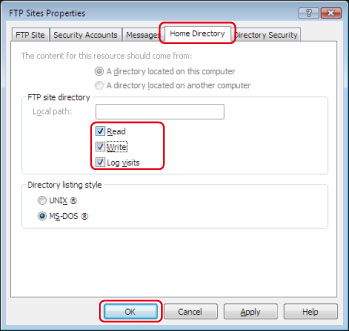
If you are using Windows 7/Server 2008 R2:
Right-click the [Sites] icon → click [Add FTP Site].
Enter the appropriate site information in the [Add FTP Site] dialog box → click [Next].
Specify the binding and SSL settings respectively → click [Next].
Deselect [Anonymous] for <Authentication>.
Select both [Read] and [Write] for <Permissions> → click [Finish].
4.
Confirm the full computer name.
If you are using Windows XP/Server 2003:
From the [Start] menu, right-click [My Computer] → select [Properties].
Click the [Computer Name] tab → confirm [Full computer name] → click [Cancel].
If you are using Windows Vista/Server 2008/7/Server 2008 R2:
From the [Start] menu, right-click [Computer] → select [Properties].
Confirm [Full computer name] → close the window.
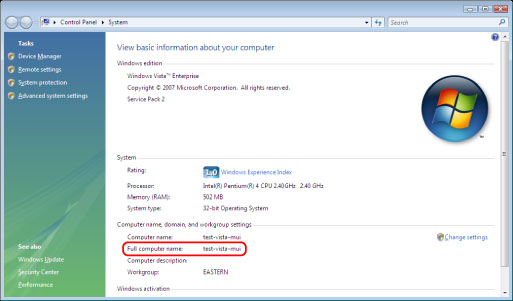
5.
Set the user and password for accessing the FTP server.
Display the window for managing the computer.
Windows XP/Server 2003: From the [Start] menu, right-click [My Computer] → select [Manage].
Windows Vista/Server 2008/7/Server 2008 R2: From the [Start] menu, right-click [Computer] → select [Manage].
Double-click [Local Users and Groups] for [System Tools] in the [Computer Management] window.
If you are using Windows Server 2008/Server 2008 R2, double-click [Configuration] under [Server Manager].
Right-click the [Users] folder → click [New User].
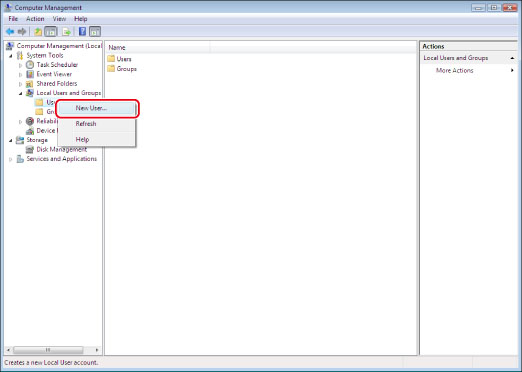
In the [New User] dialog box, enter the user name in [User name] → enter the password in [Password] → re-enter the password in [Confirm Password] → click [Create].
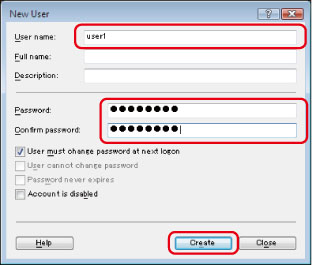
Enter a user name and a password no longer than 24 alphanumeric characters.
If you select [User must change password at next logon], any new users added must change their passwords in order to send data from the machine. (You cannot change the password from the control panel.)
|
NOTE
|
|
In the Active Directory environment, the procedures for setting up users differ from the above. For more information, see the Windows manual.
|
6.
Set a recipient address using the control panel.
Sample recipient settings:
Server side settings:
|
[Full computer name]:
|
starfish.organization.company.com
|
Create a directory named "share" in the home directory, "\lnetpub\ftproot", under [Default FTP Site]/[FTP Sites], and then set "share" as the data destination.
The machine's address settings:
|
<Protocol:>:
|
FTP
|
|
[Host Name]:
|
starfish.organization.company.com
|
|
[Folder Path]:
|
share
|
|
[User Name]:
|
User name entered in step 5
|
|
[Password]:
|
Password for the above user
|
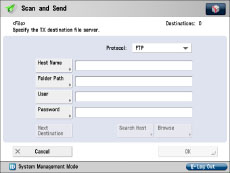
|
IMPORTANT
|
|
To use the full computer name, which was confirmed in step 4, as the host name for [Host Name] as shown in the above example, it is necessary to use a DNS server. (This applies even if the machine and the FTP server are in the same subnet.) If no DNS server is available, the setting for [Host Name] should be specified using the IP address of the FTP server.
Up to 128 alphanumeric characters can be entered for [Host Name] on the control panel. Also, up to 255 alphanumeric characters can be entered for [Folder Path]. Specify the server settings within the character limits.
If you change the language of the touch panel display, [Host Name] and [Folder Path] may not appear correctly.
If you want to send to an IPv4 host using an FTP port other than port 21, set [Host Name] using the following format:
<IPv4 address of FTP server>:<Port number> Example: 192.168.1.21:21000 To send to an IPv6 host, set [Host Name] using the following format:
<IPv6 address>:<Port number> Example: [5aed:90a0:bc05:01d2:568a:2fc0:0001:12ee]:21000 |
UNIX/Linux
For more information on the system requirements for using a UNIX/Linux computer as an FTP server, see "Sending Data."
In some environments, detailed settings may be required in order to use FTP. For details, consult the
administrator for the network you are using.
administrator for the network you are using.
1.
Log in to a workstation as a superuser → set up the users who send documents from the machine, and their passwords.
Enter a user name and a password no longer than 24 alphanumeric characters.
2.
Create a shared directory to be used for recipient addresses, and then enable read access and write access by the users who will be sending data.
3.
Set a recipient address using the control panel.
Sample recipient settings:
Server side settings:
|
Host Name:
|
starfish
|
|
Domain:
|
organization.company.com
|
The user's home directory is /home/hsato, and /home/hsato/share is the data destination.
The machine's address settings:
|
<Protocol:>:
|
FTP
|
|
[Host Name]:
|
starfish.organization.company.com
|
|
[User Name]:
|
User name entered in step 1
|
|
[Password]:
|
Password for the above user
|
Enter one of the following in [Folder Path]:
share (when using relative path)
/home/hsato/share (when using absolute path)
For a sample screen, see the example of Windows XP/Server 2003/Server 2008/Vista/7/Server 2008 R2 screen.
|
IMPORTANT
|
|
To use the host name of the above example for [Host Name], it is necessary to use a DNS server. (This applies even if the machine and the FTP server are in the same subnet.) If no DNS server is available, the setting for [Host Name] should be specified using the IP address of the FTP server.
Up to 128 alphanumeric characters can be entered for [Host Name] on the control panel. Also, up to 255 alphanumeric characters can be entered for [Folder Path]. Specify the server settings within the character limits.
If you change the language of the touch panel display, [Host Name] and [Folder Path] may not appear correctly.
If you want to send to an IPv4 host using an FTP port other than port 21, set [Host Name] using the following format:
<IPv4 address of FTP server>:<Port number> Example: 192.168.1.21:21000 To send to an IPv6 host, set [Host Name] using the following format:
<IPv6 address>:<Port number> Example: [5aed:90a0:bc05:01d2:568a:2fc0:0001:12ee]:21000 |
Mac OS X
1.
Log in to Mac OS X as an administrator.
2.
Start the FTP service on Mac OS X.
Select [System Preferences] from [Dock].
Click [Sharing] in the [System Preferences] window → select [Allow FTP access].
Click [Show All] on the toolbar.
3.
Set the user and password for sending the data.
Click [Users] in the [System Preferences] window.
In the [Users] window, enter the name of the user to whom you want to send data from the machine through Mac OS X → enter the password.
Enter a user name and a password no longer than 24 alphanumeric characters.
4.
Create a shared folder to which files are to be sent.
Sample setting:
Create a folder named "FTP_Folder" in the [Public] folder in the [Home] folder.
5.
Set the access permissions for the shared folder created in step 4.
With the shared folder selected, click [Show Info] from the [File] menu.
Select [Privileges] in [Show] → allow reading/writing for the owner and group members.
6.
Set a recipient address using the control panel.
Sample recipient settings:
Server side settings (set using the above procedure):
Create a folder named "FTP_Folder" in the [Public] folder in the [Home] folder of the user named "yoko," and then specify the FTP_Folder as the folder to which files are sent.
The machine's address settings:
|
<Protocol:>:
|
FTP
|
|
[Host Name]:
|
IP address of Macintosh
|
|
[User Name]:
|
User name entered in step 3
|
|
[Password]:
|
Password for the above user
|
Enter one of the following in [Folder Path]:
Public/FTP_Folder (If you enter a relative path)
/Users/yoko/Public/FTP_Folder (If you enter an absolute path)
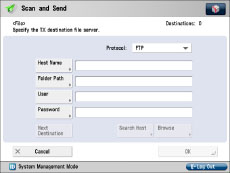
|
IMPORTANT
|
|
Up to 255 alphanumeric characters can be entered for [Folder Path] on the control panel.
If you change the language of the touch panel display, [Host Name] and [Folder Path] may not appear correctly.
If you want to send to an IPv4 host using an FTP port other than port 21, set [Host Name] using the following format:
<IPv4 address of FTP server>:<Port number> Example: 192.168.1.21:21000 To send to an IPv6 host, set [Host Name] using the following format:
<IPv6 address>:<Port number> Example: [5aed:90a0:bc05:01d2:568a:2fc0:0001:12ee]:21000 |
|
NOTE
|
|
If you are using Windows Vista, a dialog box may appear while you are performing the procedure. In this case, enter a user name and password. For more information, see the manuals provided with the operating system.
|